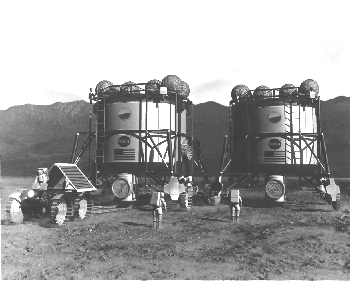
Tim Furniss/LONDON
The first flights to enable assembly of the International Space Station (ISS) to begin are scheduled to start in June, but such is the intense public interest in Mars after the Mars Pathfinder mission in 1997 that NASA is considering a more Martian-orientated approach to the later stages of the ISS, which may result in yet another major alteration to the design of its later elements.
The prototype of a manned Mars lander, which could be used on the first human expedition to the Red Planet in 2010, may be tested on the ISS in Earth orbit in 2002. Called the TransHab, the 8.22m-long, inflatable module would test the self-sustaining, closed-loop, regenerative life-support system, micro-electronics and other technology required for the three-year Mars landing and return flight to the Earth.
MANNNED MARS LANDING
NASA's Johnson Space Center (JSC) in Houston, Texas, has drawn up a reference plan for the manned Mars landing, starting with support launches in 2007 (Flight International, 20-26 August, 1997). Four engineers - two men and two women - have completed a 90-day test of the Mars flight life-support system at the JSC. The space agency has also begun designing spacesuits for the Mars mission.
The $100 million TransHab would simulate the six-person manned Habitat module in which a crew would fly to and land on the Martian surface. A second unmanned Habitat module would land earlier and the two modules would be linked together to support a ground expedition lasting 600 days.
Several other launches of Space Shuttle-derived craft and of other support spacecraft are also planned, including an ascent stage for take-off from Mars, a return-transit module for the flight to Earth, and an Apollo-like capsule for the Earth landing in about 2012.
The TransHab mission at the ISS will be like a simulation of the outward flight to Mars, but conducted in the relative safety of Earth orbit. Ryan Schaefer, of NASA JSC's Exploration Office, says that the TransHab will be based on inflatable technology which will be used in the Mars programme to save weight and money.
"To reduce the cost of habitation in space, a group from the JSC's Engineering Directorate has been developing a reliable, economic and innovative habitation concept based on inflatable technology-and their efforts were identified by the Mars exploration team as a poten- tial habitat option," says Schaefer.
The TransHab module will have a fully equip- ped, compartmentalised, solid core surrounded by an inflatable multi-layered membrane interspersed by foam padding to shield against heat and small pieces of space debris. Hypervelocity particle-impact tests have proven the materials.
The simulated Mars module has three levels, each with four sectionalised quadrants, creating 12 areas, together with a tubular central chamber which is itself divided into private quarters for each crewmember.
The TransHab will accommodate a flight- and mission-control centre, a wardroom, recreation/exercise area, airlock for spacewalking to simulate Mars exploration, a maintenance area, housekeeping and laundry room, a storage area and science quadrant.
The 3.35m-diameter, 4,535kg, TransHab would be launched in the cargo bay of the Space Shuttle. It will be inflated on reaching the space station. NASA will also study using the TransHab to supplement or eventually replace the ISS' own open-loop life-support system.
TRANSHAB POTENTIAL
The TransHab may even replace the planned US habitation module, to be launched to the ISS in 2004, but already over-budget. The TransHab would be larger than the habitation module, but would be half the weight. It would triple the volume of the habitation module but cost about the same to develop. Meanwhile, a four-person team has left a 6m life-support chamber at Houston after a 90-day simulation of a Mars flight to test a tightly controlled ecological life-support system which will be used on the TransHab. Humans will need to produce food, purify water and regenerate oxygen on planetary flights as it is not feasible to resupply these from Earth. The life-support systems test, the fourth to be conducted in Houston, has evaluated the use of biological, chemical and mechanical means to recycle all water and air and provide some of the food. Solid waste from the crew has been incinerated to produce additional carbon dioxide to sustain plant growth. Urine is recycled by an advanced biological and chemical water-recovery system.
A full-scale inflatable model of the TransHab will be tested in space conditions in October in 1999, says NASA, which is expected to announce a go-ahead for the project in July.
Source: Flight International























